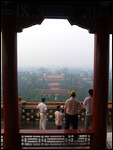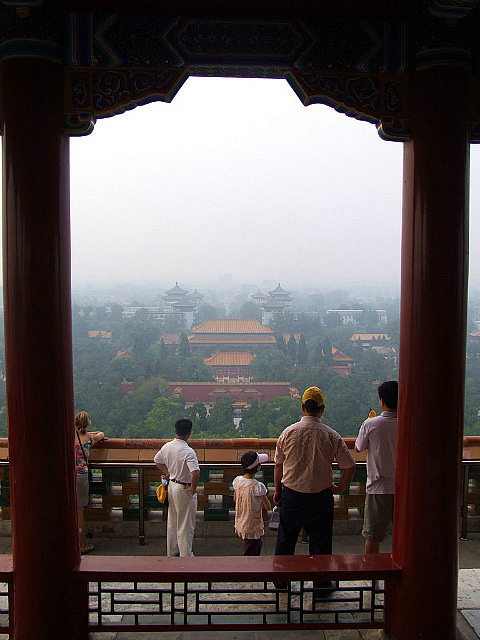Because this is Neil's first time visiting China, I accompanied Neil to visit the world-famous main sights of Beijing, taking him to places I have known intimately since childhood. Beijing has been capital of China almost continuously since 1260, it started out as a Mongolian capital built to subdue China, as a bastion for the ethnic Chinese Ming dynasty to control the Mongols, then during its zenith was ruled by the Manchu Qing Empire that saw it become the largest empire in Chinese history, incorporating all of Mongolia, Manchuria, Tibet, and much of Islamic Turkestan. As a result influences from these ethnic groups are deep-rooted in Beijing. Especially notable was how the Manchu Qing court cultivated kinship with Mongolia and Tibet by promoting Tibetan Buddhism, while keeping economically and culturally dominant ethnic Chinese at arm's length.
First day we went to the Temple of Heaven and were awed by its grand scale and precise geometric layout that reflect traditional geomantic principles. The huge grounds have been forested for hundreds of years, forming a green oasis in the big city. In the vast manicured lawns underneath the juniper groves, numerous magpies and songbirds flew about, sending flashes of breeze that disturbed the heavy, humid stillness of the hot summer. The main hall - Hall of Prayer of Good Harvest - sitting on elevated terraces with sight lines over the tops of the surrounding forest, evokes a sense of union with nature. Numerous geometrically precise walls, walkways aligned to cardinal directions, and grand gateways one after another epitomize the distinctly Chinese concept of order and control. We attended a fascinating performance of ancient ritual music in the Holy Music Bureau complex, then visited the laid-back Fasting Palace, which was surrounded by double moats to protect the emperor, who would stay here for two days per year to fast before state rituals.
Later that day we attended a party in a restored courtyard residence in an old city alley. This traditional courtyard house typical of old Beijing was rebuilt using modern materials with updated plumbing. It retains its serene, private atmosphere, with an old tree in the middle of the courtyard for greenery and shade, and an ornate privacy screen wall at the entrance gate. As most old neighborhoods in Beijing are being torn up to be replaced by high-rise developments, remaining courtyard residences have become very chic. During the party we were shown typical Chinese hospitality with vast amounts of food, while our male hosts would take turns pouring shots of baijiu (Chinese hard liquor) for us, then as a sign of brotherhood ask us to drink it dry with them. Neil was able to continue several rounds of this drinking ritual but I bailed very quickly.
The next day we went to the Great Wall at Mutianyu. I have been to two other Great Wall sites near Beijing but this is a new one for me. The drive took about an hour and half, passing mostly dense forests, many pastoral-themed tourist developments and retreats built for government officials and agencies, among which was a grandiose golf course with European-style sculptures. The weather was smoggy, extremely humid and very hot at the Great Wall, but we still decided to hike up the stone steps instead of taking the cable car. Very large butterflies of three different species showed off their beautiful patterns fluttering lazily among the verdant forests covered with wildflowers. Once on top of the wall we saw only foreign tourists, many shirtless and sweltering in the heat, climbing up and down the very steep sections huffing and puffing. Almost everywhere else one sees predominantly domestic tourists, it is quite an exception here probably due to the hot weather. One can only get shade inside the watchtowers, where many arched openings allow cross-breezes to form. The rugged architecture of the wall and its graceful curves following mountain ridges never fail to amaze, and the grand views we had in every direction changed subtly as we ascended to different watchtowers. Descending the wall, we passed through a newly constructed descent path through a rock art center with myriad strangely shaped rocks placed indoors and out, then a newly constructed tourist attraction with waterfall, duck pond, bamboo groves, and even a cave to mimic natural limestone caves.
We took another day to visit the Forbidden City, starting from the wide moat which is now used for paddle boating. We walked across perfectly manicured Zhongshan Park, formerly the Altar to Soils and Grains used by the emperor. We exited the park onto the vast Tiananmen Square lined by gargantuan ceremonial buildings, but we could hardly see the other end of the square through the smoggy air. We then entered Forbidden City through the most venerated Tiananmen Gate, or Gate of Heavenly Peace, the symbol of the People's Republic. Crowds and tour groups were everywhere, and many handsome policemen were stationed every few steps. Next we reach the main gate of the Forbidden City - Meridian Gate. It has tall, out-stretched ramparts and towers on either side, making a grand statement about the pedigree of the place. Behind this we walked a long distance and climbed up three flights of stairs to approach the largest ancient building in China - Hall of Supreme Harmony - the main throne hall. The oppressiveness of the space and the crowds of tourists made us want to find a way out of there. We exited the main complex to find the exhibition halls for imperial time pieces and treasures. Each hall was enclosed in its own courtyard compound with walls and ornate gateways, in seemingly infinite repetitions that were disorienting. The exhibitions had large collections of impressive objects but the lighting was too dark to see them well. Behind the exhibition halls we passed through several cozy, relaxing courtyards with covered galleries, plantings, ponds and rockery - the Gardens by Qianlong Emperor. This finally lead to the north gateway of Forbidden City via maze-like passageways. To gain a grand view of Forbidden City, we ascended the hill in Jingshan Park just to the north. This artificial hill was created from soils dug from the moat. We soon arrived at the top-most pavilion, hosting Buddha statues and providing grand views in every direction. The most spectacular is the view to the south over the vast, orderly array of hundreds of yellow-glazed gable roofs that is the Forbidden City.
Earlier in the same day we visited the Yonghegong Temple and the Confucius Temple, both in the northern part of old town. The Yonghegong Temple was dedicated to Tibetan Buddhism with many tantric elements, including statues of sexual union, sand mandalas, gory images of demons, and the world's largest wooden Buddha carved from a single tree. Although monks were present and many people offered incense, it seemed more like a tourist destination than a practicing place of worship. The Confucius Temple had almost no other tourists nor active worship. its courtyard was full of ancient carved stelae recording scholarly achievements. Many important stelae had pavilions constructed to protect them from the elements. Many ancient, balding juniper trees also inhabit the courtyard. The main hall is a grand building with very tall ceilings, it's lined with altars for Confucius and dozens of his disciples.
The last day in Beijing we took a brand-new subway line to the Summer Palace in the rain, which cooled down the summer heat a bit. As a child I went to the Summer Palace frequently because it was very close to home and my school. With the new subway line we entered through the unimposing north gate, then directly ascended Longevity Hill with its other-worldly Buddhist architecture. The Summer Palace was favored by Empress Dowager Cixi, who spent navy funds to reconstruct it after it was burned by Western powers during the Opium War in 1860. She saw herself as a Buddha re-incarnation and therefore endowed the Summer Palace with major Buddhist temples. Crowning the top of Longevity Hill are two temples, one of which is the astounding Temple of Buddha Fragrance. Occupying the center of a huge rectangular platform jutting out from the hill, it is a giant five-story octagonal building, bounded by covered galleries looking out toward the large Kunming Lake far below. Like Longevity Hill, Kunming Lake was also man-made whose dug-out soils became the hill. Descending the giant platform via long staircases, we soon reached the edge of the lake after passing more palace courtyards. The misty rains did not dampen the spirits of hordes of tourists riding the numerous ornate dragon-shaped ferry boats criss-crossing the lake. Via the lake side gallery we went to see the Marble Boat, an ornate European style stone palace on the water, mimicking a 19th century steam boat. We took a ferry boat to the South Lake Island, serenely floating in the misty waters of the vast lake, enjoying a panorama of palaces and galleries, elegant bridges, dikes, and distant Longevity Hill. Weeping willows line the lake everywhere, lending their feminine form to the watery landscape. We walked back toward the north gate of the park via the famous Seventeen-Arch Bridge connecting the island to the lake shore, whose numerous lion capitals were exquisitely charming. Weaving through palace compounds nestled in quite corners, we followed meandering paths among lush forests back to Longevity Hill.


